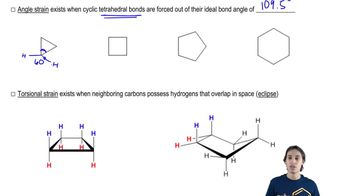The reactivity of cyclopropanes often mimics that of alkenes.
(b) Besides opening the three-membered ring, what is the driving force for this reaction?
 Verified step by step guidance
Verified step by step guidance Verified video answer for a similar problem:
Verified video answer for a similar problem:



 4:34m
4:34mMaster Acid-Catalyzed Epoxide Ring-Opening with a bite sized video explanation from Johnny
Start learning